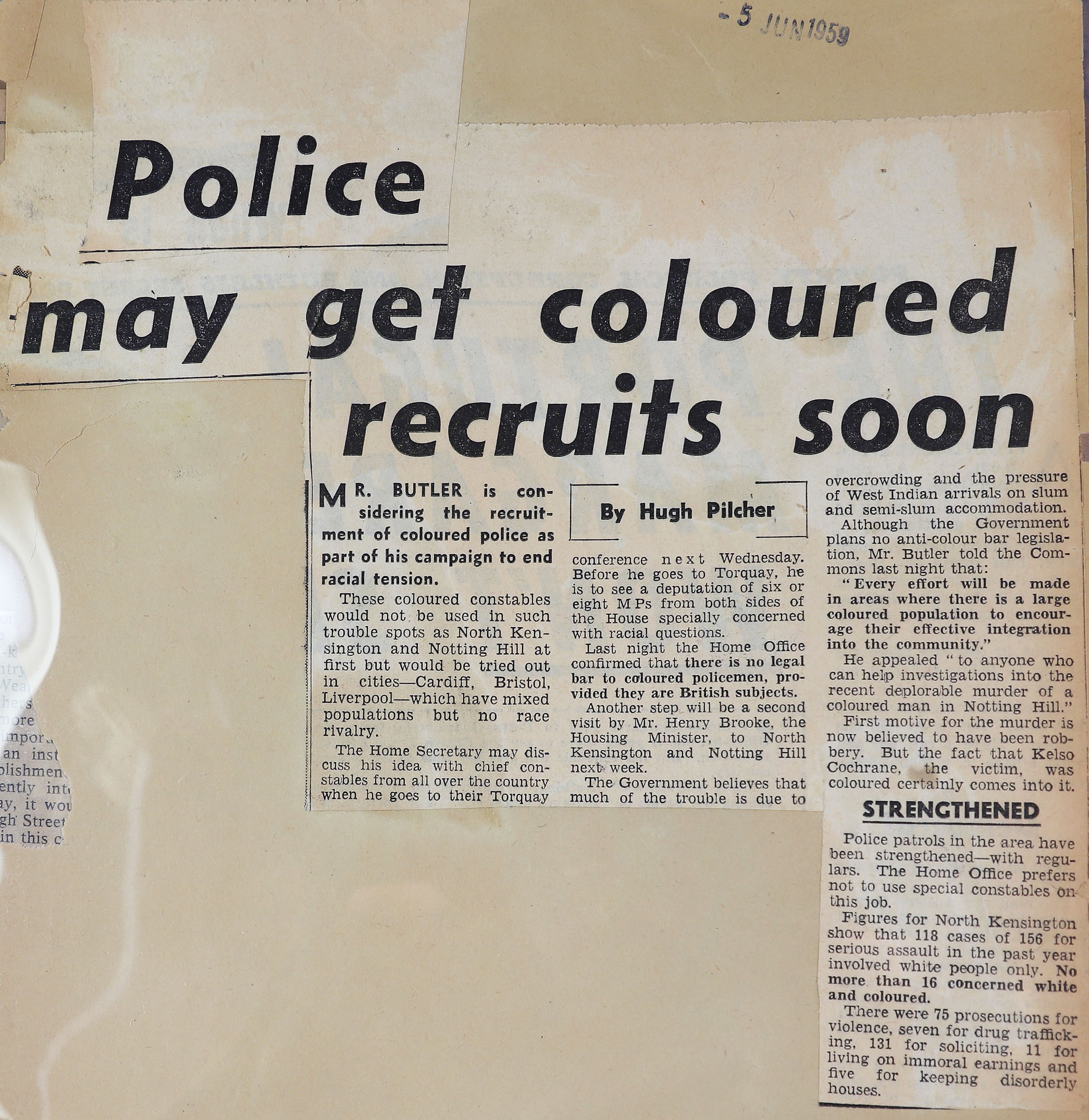
Newspaper article entitled ‘Police may get coloured recruits soon’ from the Daily Herald, 5 June 1959. Catalogue ref: HLG 117/122
The newspaper went out of print in 1964.
Contains original language used at the time, which is not appropriate today.
In 1958, Britain saw rioting in Nottingham and in a part of West London called ‘Notting Dale’, known as Notting Hill today. In this area, relations between new Caribbean migrants and the white working classes were poor. Black people were frequently excluded from skilled employment, pubs, and clubs. Landlords refused to rent to Black families. Other landlords exploited these immigrants by renting them over-priced, overcrowded accommodation. Added to this racial discrimination, the shortage of decent housing and the poor living conditions made matters worse. Racist behaviour and activities were fuelled by fascist organisations such as the White Defence League, the League of Empire Loyalists, and supporters of Oswald Mosley, as well as ‘teddy boys’ on the streets.
In the Notting Hill area, Commonwealth immigrants were attacked, and their homes damaged by gangs of young white men. A year later, Kelso Cochrane, a carpenter from Antigua, was brutally killed. It was a racist murder and not, as the police later claimed, an attempted robbery.
Following these events, there was a strong effort to improve relations in the area from Black activist Claudia Jones and members of the Caribbean community, which eventually gave rise to the Notting Hill Carnival and the start of legislation designed to prevent racial discrimination.
- Why do you think Mr Butler, Home Secretary, wished to introduce Black constables into police forces in areas ‘where there is no racial rivalry’?
- What is your view on this plan?
- Can you explain the meaning and significance of the expression ‘no legal colour bar’ as used in this article?
- How does the government explain the causes of racial tension in the area? Do you think there are other factors?
- What is the value of newspapers as historical sources?
- Find out more about the causes of the riots in Notting Hill and in Nottingham in 1958.
Transcript
Police may get coloured recruits soon By Hugh Pilcher
M Butler is considering the recruitment of coloured police as part of his campaign to end racial tension.
These coloured constables would not be used in such trouble spots as North Kensington and Notting Hill at first but would be tried out in cities -Cardiff, Bristol, Liverpool- which have mixed populations but no race rivalry.
The Home Secretary may discuss his idea with chief constables from all the over the country when he goes to their Torquay conference next Wednesday. Before he goes to Torquay, he is to see a deputation of six or eight M.Ps from both sides of the House specially concerned with racial questions.
Last night the Home Office specially confirmed that there is no legal bar to coloured policemen, provided they are British subjects.
Another step will be a second visit by Mr Henry Brooke, the Housing Minister, to North Kensington and Notting Hill next week.
The Government believes that much of the trouble is due to overcrowding and the pressure of West Indian arrivals on slum and semi-slum accommodation.
Although the Government plans no anti-colour bar legislation, Mr. Butler told the Commons last night that:
“Every effort will be made in areas where there is a large coloured population to encourage their effective integration into the community.”
He appealed to “anyone who can help investigations into the recent deplorable murder of a coloured man in Notting Hill.”
First motive for the murder is now believed to have been robbery. But the fact that Kelso Cochrane, the victim, was coloured certainly comes into it.
STRENGTHENED
Police patrols in the area have been strengthened- with regulars. The Home Office prefers not to use special constables on this job.
Figures for North Kensington show that 118 cases of 156 for serious assault in the past year involved white people only. No more than 16 concerned white and coloured.
There were 75 prosecutions for violence, seven for soliciting, 11 for living on immoral earnings and five for keeping disorderly houses.
